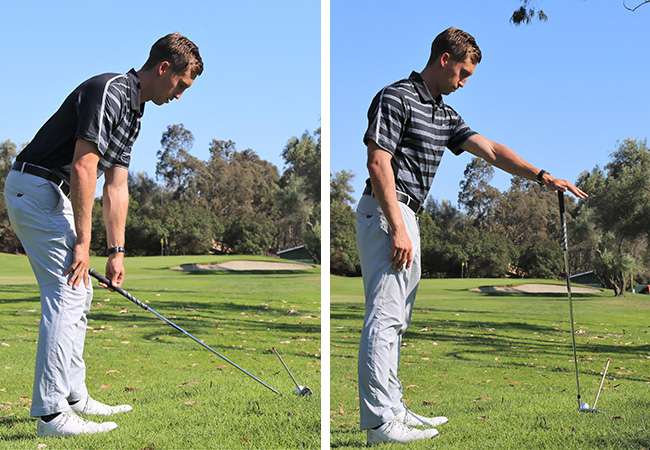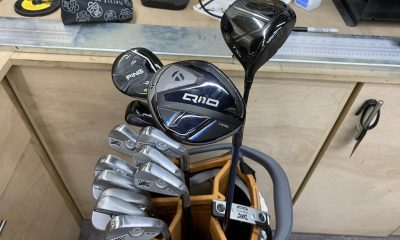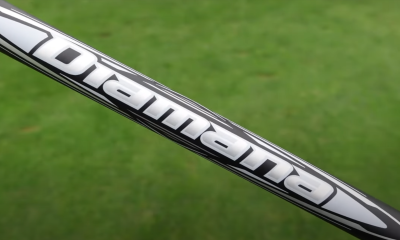Trackman tells us the truth about uneven lies (Part 1)
Starting my own golf academy this February at the Carlsbad Golf Center was a dream come true. However, being at a driving range, I had to think twice about how I would teach my players to hit shots off of uneven lies. Thankfully, I found one of the best golf training tools ever developed, called the Tuff Shot Trainer by Real Feel Golf Mats. This tool is perfect for practicing every type of lie, at any grade, when hitting on a driving range.
Using the Tuff Shot Training in conjunction with Trackman, we can work on the proper face-to-path ratios so that students can start their ball on the correct line to allow for the natural curvature back to the target.
I was interested to figure out what specifically changed when the ball was above or below a golfer’s feet. The general rule of thumb is that when the ball is above your feet, it tends to go left for the right-handed golfers, and when below your feet, it will go to the right.
“Is this because of the path or the face, and why?” I wanted to know.
I knew I could use my Trackman to help figure this out. I tested with my 6 iron, a PXG 0311T with a standard lie angle. I put my Tuff Shot at an 8-degree grade, starting with the ball above my feet. Then I hit 20 shots, and repeated the same process with the ball below my feet at the same 8-degree grade.
Based on the Trackman results, the differentiators between the two lies at impact were:
- The face angle.
- The swing plane.
On average, the shaft plane at impact was 10 degrees flatter when the ball was above my feet compared to when it was below my feet. As a result, the club face, more than the club path, tended to change at impact depending if the ball was above or below my feet.

The flatter the shaft at impact, the more the sweet spot points left. The more upright the shaft at impact the more the sweet spot points right.
I attribute a large portion of this to the shaft plane at impact being flatter or more vertical. This changes the direction that the center of the face is pointing upon impact.
The Data Collected
For someone who hits the ball relatively straight, here is why you need to aim right when the ball is above your feet:
- The club face is going to be closed to the path at impact when the ball is above your feet. The more above the feet, the more it will be closed. Also, the ball starts closer to where the face is pointed at impact than the path at impact. So when you aim at the target, the ball will start left and go more left, which obviously is not ideal.
If you aim right:
- Aiming right will get the face open enough — relative to the target line — but will be closed to the path and will allow for the ball to start right and finish at the target.
Here are some general setup tips when the ball is above your feet in an uneven lie:
- Start by standing closer and taller than you normally would. The greater the slope the more important this is.
- Choke down on the club to help get the shaft more upright and to avoid fat shots.
- Aim your entire body to right field so the ball can start right of the target before it curves to the left.
- Take one more club to compensate for choking down on the shaft.
- Finally, commit to the swing and trust that the ball will come back to the left.
- LIKE96
- LEGIT15
- WOW1
- LOL0
- IDHT0
- FLOP0
- OB0
- SHANK20
Instruction
Clement: Laid-off or perfect fade? Across-the-line or perfect draw?

Some call the image on the left laid off, but if you are hitting a fade, this could be a perfect backswing for it! Same for across the line for a draw! Stop racking your brain with perceived mistakes and simply match backswing to shot shape!
- LIKE0
- LEGIT0
- WOW0
- LOL0
- IDHT0
- FLOP0
- OB0
- SHANK1
Instruction
The Wedge Guy: The easiest-to-learn golf basic

My golf learning began with this simple fact – if you don’t have a fundamentally sound hold on the golf club, it is practically impossible for your body to execute a fundamentally sound golf swing. I’m still a big believer that the golf swing is much easier to execute if you begin with the proper hold on the club.
As you might imagine, I come into contact with hundreds of golfers of all skill levels. And it is very rare to see a good player with a bad hold on the golf club. There are some exceptions, for sure, but they are very few and very far between, and they typically have beat so many balls with their poor grip that they’ve found a way to work around it.
The reality of biophysics is that the body moves only in certain ways – and the particulars of the way you hold the golf club can totally prevent a sound swing motion that allows the club to release properly through the impact zone. The wonderful thing is that anyone can learn how to put a fundamentally sound hold on the golf club, and you can practice it anywhere your hands are not otherwise engaged, like watching TV or just sitting and relaxing.
Whether you prefer an overlap, interlock or full-finger (not baseball!) grip on the club, the same fundamentals apply. Here are the major grip faults I see most often, in the order of the frequency:
Mis-aligned hands
By this I mean that the palms of the two hands are not parallel to each other. Too many golfers have a weak left hand and strong right, or vice versa. The easiest way to learn how to hold the club with your palms aligned properly is to grip a plain wooden ruler or yardstick. It forces the hands to align properly and shows you how that feels. If you grip and re-grip a yardstick several times, then grip a club, you’ll see that the learning curve is almost immediate.
The position of the grip in the upper/left hand
I also observe many golfers who have the butt of the grip too far into the heel pad of the upper hand (the left hand for right-handed players). It’s amazing how much easier it is to release the club through the ball if even 1/4-1/2″ of the butt is beyond the left heel pad. Try this yourself to see what I mean. Swing the club freely with just your left hand and notice the difference in its release from when you hold it at the end of the grip, versus gripping down even a half inch.
To help you really understand how this works, go to the range and hit shots with your five-iron gripped down a full inch to make the club the same length as your seven-iron. You will probably see an amazing shot shape difference, and likely not see as much distance loss as you would expect.
Too much lower (right) hand on the club
It seems like almost all golfers of 8-10 handicap or higher have the club too far into the palm of the lower hand, because that feels “good” if you are trying to control the path of the clubhead to the ball. But the golf swing is not an effort to hit at the ball – it is a swing of the club. The proper hold on the club has the grip underneath the pad at the base of the fingers. This will likely feel “weak” to you — like you cannot control the club like that. EXACTLY. You should not be trying to control the club with your lower/master hand.
Gripping too tightly
Nearly all golfers hold the club too tightly, which tenses up the forearms and prevents a proper release of the club through impact. In order for the club to move back and through properly, you must feel that the club is controlled by the last three fingers of the upper hand, and the middle two fingers of the lower hand. If you engage your thumbs and forefingers in “holding” the club, the result will almost always be a grip that is too tight. Try this for yourself. Hold the club in your upper hand only, and squeeze firmly with just the last three fingers, with the forefinger and thumb off the club entirely. You have good control, but your forearms are not tense. Then begin to squeeze down with your thumb and forefinger and observe the tensing of the entire forearm. This is the way we are made, so the key to preventing tenseness in the arms is to hold the club very lightly with the “pinchers” — the thumbs and forefingers.
So, those are what I believe are the four fundamentals of a good grip. Anyone can learn them in their home or office very quickly. There is no easier way to improve your ball striking consistency and add distance than giving more attention to the way you hold the golf club.
More from the Wedge Guy
- The Wedge Guy: Golf mastery begins with your wedge game
- The Wedge Guy: Why golf is 20 times harder than brain surgery
- The Wedge Guy: Musings on the golf ball rollback
- LIKE88
- LEGIT15
- WOW6
- LOL1
- IDHT0
- FLOP4
- OB1
- SHANK8
Instruction
Clement: Stop ripping off your swing with this drill!

Not the dreaded headcover under the armpit drill! As if your body is defective and can’t function by itself! Have you seen how incredible the human machine is with all the incredible feats of agility all kinds of athletes are accomplishing? You think your body is so defective (the good Lord is laughing his head off at you) that it needs a headcover tucked under the armpit so you can swing like T-Rex?
- LIKE0
- LEGIT3
- WOW2
- LOL0
- IDHT0
- FLOP0
- OB0
- SHANK2
-

 19th Hole3 weeks ago
19th Hole3 weeks agoJustin Thomas on the equipment choice of Scottie Scheffler that he thinks is ‘weird’
-

 19th Hole3 weeks ago
19th Hole3 weeks ago‘Absolutely crazy’ – Major champ lays into Patrick Cantlay over his decision on final hole of RBC Heritage
-

 19th Hole2 weeks ago
19th Hole2 weeks agoLET pro gives detailed financial breakdown of first week on tour…and the net result may shock you
-

 19th Hole4 days ago
19th Hole4 days agoReport: LIV star turns down PGA Championship invite due to ‘personal commitments’
-

 19th Hole1 week ago
19th Hole1 week agoGary Player claims this is what ‘completely ruined’ Tiger Woods’ career
-

 Whats in the Bag2 weeks ago
Whats in the Bag2 weeks agoTeam McIlowry (Rory McIlroy, Shane Lowry) winning WITBs: 2024 Zurich Classic
-

 Equipment3 days ago
Equipment3 days agoDetails on Justin Thomas’ driver switch at the Wells Fargo Championship
-

 Equipment1 week ago
Equipment1 week agoGolf fans left surprised by LIV’s choice of course for its 2024 individual championship event












Pingback: Trackman tells us the truth about uneven lies (Part 2) - Dan Hansen Golf Instruction
Peter Maki
Jul 27, 2016 at 5:29 pm
Sure the swing plane is different because the slope dictates it. Lie angle is the biggest reason shots curve more and start more left/right off of slopes.
Steven
Jul 20, 2016 at 3:28 pm
Good article Devan. I like that the technology confirmed what we all intuitively believed. I also like the explanation. It would help a little to know how far to the right or how far to left to aim.
Keep up the good work.
Bert
Jul 20, 2016 at 12:37 pm
Nice and simple – just right for me, simple!
alan
Jul 20, 2016 at 7:45 am
haha
Grim
Jul 19, 2016 at 11:48 am
You do realize it’s quite easy to hit straight shots from uneven lies?
The main reason the ball goes left when above your feet and right below, is because of the out of balance reaction your body has during the swing.
This teaching method of aiming to adjust for these types of shots is wrong and very outdated.
Smacked
Jul 19, 2016 at 12:51 pm
So’s your face
Bob Pegram
Jul 20, 2016 at 2:59 pm
It works for most people. It is easier than trying to change your entire swing balance on one shot.
However, explain what you mean. I am curious.
John
Jul 21, 2016 at 2:24 pm
uh, no?
On all shots with all clubs, the ball has backspin. Backspin is created by the ball “rolling up” the face perpendicular to the sole angle. This is known. Physics also dictates that backspin will cause the ball to move “up” through the air perpendicular to the axis of spin. Obviously gravity fights this, but that is why you see that “balooning” ball flight. So, with a square face-to-path, this axis of spin will be parallel to the sole angle. If we put those pieces together, ball above your feet=sole angled left=axis angled left=ball goes left.
Also important to note that the face angle itself, due to the loft, will be offline, meaning the ball will start left or right of your line, then curve from there. Both the line and spin will be more affected by higher-lofted clubs. (This is the bit about the face being “closed” above, although he did kind of a poor job of expressing what that really means. The club face would appear square to you, but you have to consider the loft of the face as well, which will now be pointing left or right. The pics do a better job of showing that.)
This is why lie angle is a fitting criteria–if you’re delivering the club too upright or laid back, you’ll need to compensate other ways or the ball will always move right or left, respectively.
Howard
Jul 19, 2016 at 10:23 am
Is that the Carlsbad Golf Center? Go Aztecs!
James
Jul 19, 2016 at 2:52 pm
Yes it is! Spent 16 good months there with the Golf Academy of America in 08/09